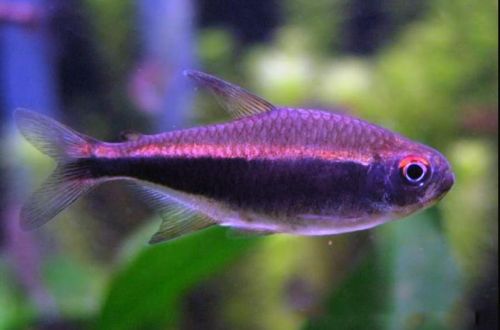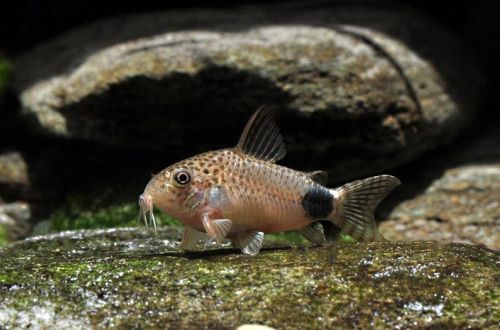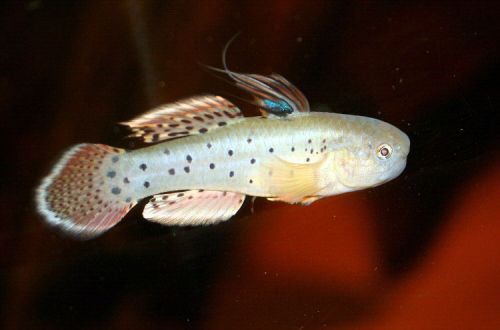
Purple Tetra
Purple Tetra or Tetra Meta, scientific name Hyphessobrycon metae, belongs to the Characidae family (Characinidae). A small, active fish that makes a great addition to any freshwater aquarium. Easy to keep and breed, compatible with many other species.

Contents
Habitat
It comes from South America from the middle basin of the Orinoco River from the territory of Colombia and Venezuela. The largest number of references to this species relate to the Meta River, the largest tributary of the Orinoco. The fish is found in various biotopes from streams and rivers with clear water and sandy substrates, to swamps and backwaters with an abundance of fallen leaves and snags, the water in which has a rich brown color. During the rainy season, fish swim in the flooded areas of the rainforest.
Brief information:
- The volume of the aquarium – from 80 liters.
- Temperature – 20-28°C
- Value pH — 4.0–7.0
- Water hardness – 1–10 dGH
- Substrate type – sandy
- Lighting – subdued or moderate
- Brackish water – no
- Water movement is weak
- The size of the fish is about 4 cm.
- Feeding – any food of suitable size
- Temperament – peaceful
- Content flocking from 8-10 individuals
Description
Adult individuals reach a length of up to 4 cm. Sexual dimorphism is weakly expressed, males and females are practically indistinguishable. The body color is dark with a light belly. The scales of fish have a high degree of refraction of light, which is why the color can change depending on the lighting, acquiring blue, silver or purple hues.
Food
Omnivorous species, accepts most popular foods designed for aquarium fish. The daily diet may consist exclusively of dry food in the form of flakes or pellets. Live or frozen foods (brine shrimp, daphnia, bloodworms) are recommended and will be a great addition.
Maintenance and care, arrangement of the aquarium
The optimal size of an aquarium for a flock of 8-10 fish starts at 80 liters. The design is not of fundamental importance, the Purple Tetra is able to adapt to different environments. However, decoration reminiscent of the natural environment is preferred. The fish look more harmonious, swimming among the snags and thickets of plants in subdued light.
Experienced aquarists often add tannins to the leaves of some trees, which, during decomposition, release tannins into the water. Thus, the chemical composition of water, characteristic of natural reservoirs, is recreated.
A balanced and sustainable ecosystem is the key to successful content. It is necessary to maintain high water quality within an acceptable range of hydrochemical values and temperatures, and also to prevent the accumulation of nitrogen cycle products (ammonia, nitrites, nitrates) to dangerous concentrations. Special equipment (filters, heaters, etc.) and regular aquarium maintenance procedures ensure the desired stability.
Behavior and Compatibility
Peaceful schooling fish, in nature forms large clusters, numbering hundreds of individuals. In a home aquarium, it is desirable to maintain a group size of at least 8-10 fish. With a smaller number, they can become overly shy. Compatible with other non-aggressive species of comparable size.
Breeding / breeding
Breeding is typical of most Kharatsin. With the onset of the mating season, females scatter eggs among plants, and males fertilize it. Parental instincts are not developed, so adult fish are able to eat their own offspring. In order to preserve the brood, the eggs or hatched fry should be moved to a separate tank with identical water conditions, where they will remain until they are large enough.
Fish diseases
Diseases inherent in this particular species of fish were not noted. When kept in suitable conditions (high water quality, balanced diet, non-conflict neighbors, etc.), health problems are not observed. The most common cause of disease is the deterioration of conditions leading to immune suppression, which makes the fish susceptible to infections that are invariably present in the surrounding area. When the first signs of an illness are detected (lethargy, exhaustion, refusal of food, lowered fins, etc.), it is necessary to immediately check the main parameters of the water. Often, the restoration of acceptable living conditions contributes to self-healing, but if the fish is too weak or has received obvious damage, medical treatment will be required. For more information on symptoms and treatments, see the Aquarium Fish Diseases section.





